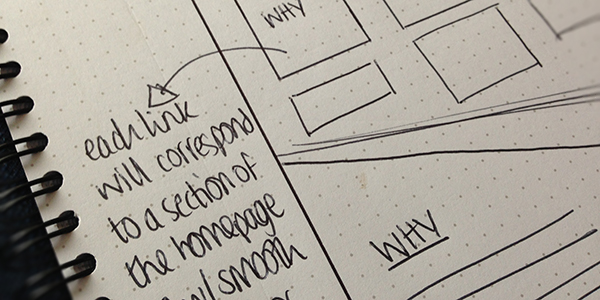Once you’ve finished working with your content – great news! You get to start thinking about the actual design. But not so fast – don’t jump onto a computer straight away.
If you talk to designers, most of them will tell you that it’s a massive part of their workflow to firstly sketch out any ideas they may have.
When sketching, you don’t have to draw really pretty pictures or make sure the sketches you do are neat – the idea is to visually note down as many ideas as possible, as quickly as possible.
Jason Santa Maria put it brilliantly at New Adventures in January 2013 when he said that you can get all the “ugly ideas” down – that way, you get rid of all of the rubbish ideas first, before you focus your ideas into a proper design.
The key to good sketches is to just go with the flow – complete as many as you’re comfortable with and play around with design elements (such as the way that quotes might be displayed, or how to make a feature out of a particular piece of content) or look at how you imagine the rough layout of the design might be.
Experiment!
The best thing you can do with sketching is to experiment. It doesn’t matter if you make a mistake, or something doesn’t look right to you, as you can easily just move on to the next sketch.
At the end of the day, this is something that you are doing that can help you to get a feeling for the design. When you’re new to designing, it’s a great way to ease yourself into the design stage and think in a disorganised way about how things could work.
Top Tips for Sketching

1. Have fun With it
Just pick up a pencil (or pen, whatever takes your fancy) and paper and play around with ideas and sketching. Most of my sketchbooks look shocking, full of messy scribbles and ideas – but that’s okay.
2. Explore Your Ideas
The main point of sketching is to get ideas down and explore any ideas you might come up with further – whether that’s through more sketching and playing around with layout or through researching something a little more thoroughly.
There are mostly three kinds of ideas: ideas that are great from the beginning; ideas that need a little work (or a lot of work!) to go from mediocre to good; and those ideas that are just plain bad and won’t work.
Remember that exploring your ideas means taking a good look at both your good and bad ideas and working to improve them. Taking the time to experiment and explore your ideas means that you’ll start to understand how your ideas fit into the above categories. Basically, the more time that you spend playing around with your ideas and seeing how they can be improved – or if they should be – the more that you’ll start to see what makes a good idea and when to put that extra effort in.
3. Document Your Ideas!
One of the best things you can do with sketching is to document and write about what you’ve done. This is as easy as writing the tiniest bit of information about what you’ve done at the side (but add more, if you want to).

The reason I suggest writing about your ideas (or at least the ones you like or prefer exploring more) is because it helps to have a clear explanation of your idea at that moment in time, in case you come back to it later and either interpret that idea differently (which is sometimes brilliant and can move an idea forward) or completely forget what it was about.
Further Reading
- Sketching: How a Simple Pen and Paper Can Transform Your Web Designs
- The Role of Sketching in the Design Process
Assignments
- Sketch out ideas for your next project – start playing with ideas for typography, form, layout and more. Be as creative as possible and don’t restrict yourself to one particular style or look – try to have fun with it and be as wacky and imaginative as you can.
- Once you’ve sketched out lots of rough ideas, try refining a few more and exploring certain ideas you like in more detail. Then, try annotating your sketches, explaining and justifying the decisions you’ve made and the ideas that you have.
